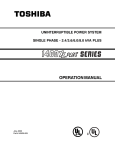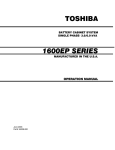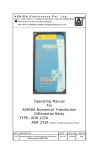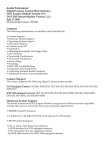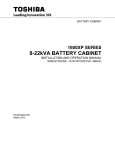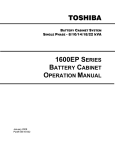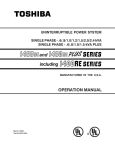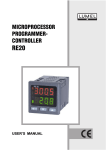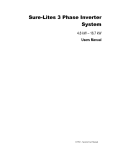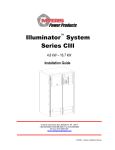Download 4 - ElectricalPartManuals.com
Transcript
TOSHIBA Battery Cabinet System SINGLE PHASE - 2.4/3.6/6.0/8.0 KVA PLUS MANUFACTURED IN THE U.S.A. OPERATION MANUAL October, 1996 Part # 43241-002 TOSHIBA TOSHIBA NOTE These instructions are not intended to cover all of the details or variations in equipment, nor to provide for every possible contingency to be met in connection with installation, operation, or maintenance. This manual may change without notice. Contact your local Toshiba sales office to verify that this is the latest revision. Should further information be desired or should particular problems arise which are not covered sufficiently for the purchaser's purposes, the matter should be referred to the local Toshiba sales office. The contents of this instruction manual shall not become a part of or modify any prior or existing agreement, commitment, or relationship. The sales contract contains the entire obligation of Toshiba International Corporation's UPS Division. The warranty contained in the contract between the parties is the sole warranty of Toshiba International Corporation's UPS Division and any statements contained herein do not create new warranties or modify the existing warranty. UNINTERRUPTIBLE POWER SUPPLY Please complete the enclosed Extended Warranty Card and return it by prepaid mail to Toshiba. This activates the extended warranty. If additional information or technical assistance is required call Toshiba's marketing department toll free at 1-800-231-1412 or write to: Toshiba International Corporation, 13131 W. Little York Road, Houston, TX 77041-9990. Please complete the following information for your records and to remain within this equipment manual: Model Number: Serial Number: Date of Installation: Inspected By: i TOSHIBA GENERAL SAFETY INSTRUCTIONS Warnings in this manual appear in any of four ways: 1) Danger- The danger symbol is a lightning bolt mark enclosed in a triangle which precedes the 3/16" high letters spelling the word "DANGER". The danger symbol is used to indicate imminently hazardous situations, locations, and conditions which, if not avoided, WILL result in death, serious injury, and/or severe property damage. DANGER 2) Warning - The warning symbol is an exclamation mark enclosed in a triangle which precedes the 3/16" high letters spelling the word "WARNING". The warning symbol is used to indicate potentially hazardous situations and conditions which, if not avoided COULD result in serious injury or death. Severe property damage COULD also occur. WARNING 3) Caution - The caution symbol is an exclamation mark enclosed in a triangle which precedes the 3/16" high letters spelling the word "CAUTION". The caution symbol is used to indicate potentially hazardous situations and conditions which, if not avoided may result in injury. Equipment damage may also occur. CAUTION 4) Attention warnings - The attention warning symbol is an exclamation mark enclosed in a triangle which precedes the 3/16" high letters spelling the word "ATTENTION". The Attention warning symbol is used to indicate situations and conditions that can cause operator injury and/or equipment damage: ATTENTION Other warning symbols may appear along with the Danger and Caution symbol and are used to specify special hazards. These warnings describe particular areas where special care and/or procedures are required in order to prevent serious injury and possible death: 1) Electrical warnings - The electrical warning symbol is a lighting bolt mark enclosed in a triangle. The Electrical warning symbol is used to indicate high voltage locations and conditions that may cause serious injury or death if the proper precautions are not observed: 2) Explosion warnings - The explosion warning symbol is an explosion mark enclosed in a triangle. The Explosion warning symbol is used to indicate locations and conditions where molten, exploding parts may cause serious injury or death if the proper precautions are not observed: ii TOSHIBA CONTENTS SECTION PAGE Disclaimer ............................................................................................................. i General Safety Instructions ................................................................................. ii Contents ............................................................................................................... iii 1.0 Important Safety Instructions ............................................................................ 1-1 2.0 Inspection/Storage/Disposal ............................................................................. 2-1 2.1 Inspection of the new Battery System ...................................................... 2-1 2.2 Storage of the Battery System .................................................................. 2-1 2.3 Disposal .................................................................................................... 2-1 3.0 Precautions ......................................................................................................... 3-1 3.1 Installation Precautions ............................................................................. 3-1 3.2 Prestart Precautions ................................................................................. 3-1 3.3 Operating Precautions .............................................................................. 3-1 4.0 UPS Connections ............................................................................................... 4-1 4.1 Power Connections .................................................................................. 4-1 4.2 Terminal Block Details .............................................................................. 4-1 4.3 Wire Size and Tightening Torque ............................................................. 4-1 5.0 6.0/8.0KVA Connection ...................................................................................... 5-1 5.1 Battery connections .................................................................................. 5-1 5.2 Illustration ................................................................................................. 5-1 5.3 Connection Procedure .............................................................................. 5-1 5.4 Charger connection .................................................................................. 5-1 6.0 2.4/3.6KVA Connection ...................................................................................... 6-1 6.1 Battery connections .................................................................................. 6-1 6.2 Illustration ................................................................................................. 6-1 6.3 Connection Procedure .............................................................................. 6-1 6.4 Charger connection .................................................................................. 6-1 7.0 Preventative Maintenance/Parts Replacement ................................................ 7-1 7.1 Preventative Maintenance ........................................................................ 7-1 7.2 Parts Replacement ................................................................................... 7-1 8.0 External Layouts ................................................................................................ 8-1 8.1 External layouts ........................................................................................ 8-1 8.2 Dimensions ............................................................................................... 8-1 8.3 Shipping Weights ...................................................................................... 8-1 9.0 EPO connection .................................................................................................. 9-1 9.1 Shunt Trip ................................................................................................. 9-1 9.2 Connection diagram ................................................................................. 9-1 iii TOSHIBA IMPORTANT SAFETY INSTRUCTIONS manual contains important instructions SAVE THESE INSTRUCTIONS This for models UC3-BC-0230, 0260, 0330, 0360, 0630, 0660, and 0830 that should be followed during the installation and maintenance of the Battery System. The maximum ambient temperature in which the Battery System should be operated is 40° C. The nominal battery voltages for these models are as follows: 2.4 KVA: 96VDC 3.6 KVA: 144VDC 6.0 KVA: 216VDC 8.0 KVA: 252VDC Servicing of the batteries should only be performed by a qualified Toshiba Representative who is knowledgeable of batteries and the required precautions. Keep unauthorized personnel away from batteries. When replacing batteries, use the same number and type of one of the following sealed, lead-acid batteries: Model Capacity Manufacturer Type UC3-BC-0230 8 UC3-BC-0260 UC3-BC-0330 Quantity 24 Yuasa NP7-12FR 12 UC3-BC-0360 36 UC3-BC-0630 18 UC3-BC-0660 54 UC3-BC-0830 42 CAUTION Misuse of this equipment could result in human injury and equipment damage. In no event will Toshiba Corporation be responsible or liable for either indirect or consequential damage or injury that may result from the use of this equipment. CAUTION Do not dispose of the batteries in a fire. The batteries may explode. CAUTION Do not open or mutilate the batteries. Released electrolyte is harmful to the eyes and skin and could also be toxic. WARNING This unit contains sealed lead acid batteries. Lack of preventative maintenance could result in batteries exploding and emitting gasses and/or flame. Annual preventative maintenance must be performed by an authorized, trained technician. WARNING Failure to replace a battery before it becomes exhausted may cause the case to crack, possibly releasing electrolytes from inside the battery, and resulting in secondary faults such as odor, smoke, and fire. WARNING Installation and servicing of batteries should be performed by personnel knowledgeable of batteries and the required precautions. Keep unauthorized personnel away from the batteries. 1-1 TOSHIBA IMPORTANT SAFETY INSTRUCTIONS WARNING Proper maintenance to the battery system of this unit must be done by a qualified service techincian, this is essential to the safety and reliability of your UPS system. Refer to service manual. DANGER A battery can present a risk of electrical shock and high short circuit current. The following precautions should be observed when working with batteries: 1) Verify that the UPS is off and that the power cord is disconnected from the power source. 2) Remove watches, rings or other metal objects. 3) Use tools with insulated handles to prevent inadvertent shorts. 4) Wear rubber gloves and boots. 5) Do not lay tools or metal parts on top of batteries. 6) Determine if the battery is inadvertently grounded. If inadvertently grounded, remove source of ground. Contact with any part of a grounded battery can result in electrical shock. The likelihood of such shock will be reduced if such grounds are removed during installation and maintenance. 7) Verify circuit polarities prior to making connections. 8) Disconnect charging source and load proir to connecting or diconnecting terminals. 9) VRLA batteries contain an explosive mixture of hydrogen gas. Do not smoke, cause a flame or spark in the immediate area of the batteries. This includes static electricity from the body. 10) Do not attempt to open the batteries in order to add water or sample the specific gravity of the electrolyte. The batteries are valve regulated lead acid type and such servicing is not possible without damaging the battery. 11) Use proper lifting means when moving batteries and wear all appropriate safety clothing and equipment. 12) Do not dispose of lead acid batteries except through channels in accordance with local, state and federal regulations. INSTRUCTIONS IMPORTANTES CONCERNANT LA SÉCURITÉ CONSERVER CES INSTRUCTIONS Cette notice contient des instructions importantes concernant la sécurité. ATTENTION Un battery puet présenter un risque de choc électrique, de brûlure par transfert d' énergie. ATTENTION Por le replacement, utiliser le même nombre de batteries du modéle suivant. Model Capacity Manufacturer Type UC3-BC-0230 8 UC3-BC-0260 UC3-BC-0330 Quantity 24 Yuasa NP7-12FR 12 UC3-BC-0360 36 UC3-BC-0630 18 UC3-BC-0660 54 UC3-BC-0830 42 ATTENTION © Copyright 1994 L' élimination des batteries est règlementèe. Consultar les codes locaux à cet effet. 1-2 TOSHIBA 2.0 Inspection/Storage/Disposal 2.1 Inspection of the new Battery System Upon receipt of the Battery System, a careful inspection for shipping damage should be made. After Uncrating: 1) Check the unit for loose, broken, bent or otherwise damaged parts. If damage has occurred during shipment, keep all original crating and packing materials for return to shipping agent. Warranty will not apply to units which are damaged during shipment. 2) Check to see that the rated capacity and the model number specified on the nameplate conform to the order specifications. 2.2 Storage of Battery equipment. If the Battery System is to be subjected to long or short term storage the following guidelines should be used. Avoid: 1) Storage in sites subject to extreme changes in temperature or high humidity. 2) Storage in sites subject to exposure of high levels of dust or metal particles. 3) Storage on inclined floor surfaces or in sites subject to excessive vibration. Before storing: 1) Charge the system's batteries. 2) Place the Battery System's input switch (MCCB-C) in the OFF position. Storing: 1) Store within a temperature range of -20° to 40° C (-4° to 104° F). 2) For best results, store the UPS in the original shipping container and place on a wood or metal pallet. 3) The optimum storage temperature is 21° C (70° F). Higher ambient temperatures cause UPS batteries to need recharging more frequently. 4) Batteries need to be recharged to maintain life during storage. Please follow recomended recharges for your condition. A) If stored in an ambient temperature under 20° C (68° F); recharge the batteries every 9 months. B) If stored in an ambient temperature of 20° to 30° C (68° to 86° F); recharge the batteries every 6 months. C) If stored in an ambient temperature of 30° to 40° C (86° to 104° F); recharge the batteries every 3 months. 2.3 Disposal Please contact your state environmental agency for details on disposal of electrical components and packaging in your particular area. It is illegal to dump lead-acid batteries in landfills or dispose of improperly. Please help our Earth by contacting the environmental protection agencies in your area, the battery manufacturer, or call Toshiba toll-free at 1-800-231-1412 for more information about recycling. 2-1 TOSHIBA 3.0 Precautions 3.1 3.2 CAUTION Installation Precautions 1) Install the unit in a well ventilated location; allow at least 10 cm (4 inches) on all sides for air ventilation and for maintenance. 2) Install the unit in a stable, level, and upright position which is free of vibration. 3) Install the unit where the ambient temperature is within the correct operating range. 4) Do not install the Battery System in areas that are subject to high humidity. 5) Do not allow direct sunlight to shine on the unit. 6) Do not install the Battery System in areas which are subject to contamination such as high levels of airborne dust, metal particles, or inflammable gas. 7) Avoid installation near sources of electrical noise and always make sure that the unit ground is intact to prevent electrical shock and to help reduce electrical noise. 8) Do not install where water or any foreign object/substances may get inside the Battery System. Prestart Precautions 1) CAUTION Before connecting the Battery System to the UPS verify that the two cabinets are compatible by comparing them to the following chart. UPS Model Number Battery Cabinet Model Number UC3G2L024C6(#) UC3A2L024C6(#) UC3-BC-0230 UC3-BC-0260 UC3G2L036C6(#) UC3-BC-0330 UC3-BC-0360 UC3G2L060C6(#) UC3-BC-0630 UC3-BC-0660 UC3G2L080C6(#) UC3-BC-0830 DO NOT attempt to connect if the Model numbers do not match the above chart. This will result in damage to the UPS, the Battery System, or both. Call your Toshiba representative if you should have any questions. Before connecting the Battery System to the UPS; move the (MCCB-C) switch (ON/OFF), on the rear panel (See Sections 5 & 6), to the OFF position. WARNING 2) 3.3 Operating Precautions 1) CAUTION The Battery Cabinet should not be powered up until the entire operation manual has been reviewed. 3-1 TOSHIBA 4.0 Power Connections 4.1 Power Connections The following illustration details the wiring connections from the power distribution panel (not part of the UPS) to the UPS unit and the Battery unit. This connection diagram is to be used with the following Battery units: UC3-BC-0230, 0260, 0330, 0360, 0630, 0660, and 0830. Main UPS Unit 11 Source Power Distribution Panel 208VAC 12 240VAC 13 L1 L2 G 1 H2 MCCB 8 2 H1 3 MCCB-B +BUS Battery Unit 3 P P N N 16 4 MCCB-C Charger NOTE: The following model numbers do not require the +Bus connection: (UC3-BC-0230, UC3-BC-0330, and UC3-BC-0630) 4.2 Terminal Block details The following illustration is a detail of the Battery Cabinets terminal block (see sections 5 & 6 for terminal block location). BATTERY BREAKER SIZING 1 2 3 4 MCCB-C EPO EPO G +BUS Breaker 120VAC L N Customer Supplied 4.3 Battery Charger MODEL BREAKER UC3-BC-0230 UC3-BC-0260 32A 250VDC UC3-BC-0330 UC3-BC-0360 32A 250VDC UC3-BC-0630 UC3-BC-0660 32A 250VDC UC3-BC-0830 32A 500VDC Wire Size and Tightening Torques Terminal blocks 1 and 2 are used for wiring the EPO of the Battery System Terminal block 3 is used to connect the battery cabinet to UPS ground. Terminal block 4 is used to supply power to the internal battery charger circuit of the battery cabinet. The entire terminal block accepts #6 to #16 Awg. (Tightening torque is 13 inch-pounds minimum). Use copper 90° C wire only. Recommended Wire Size Battery Cabinet EPO (Terminal Blocks 1 & 2) Gnd. (Terminal Block 3) +Bus (Terminal Block 4) 2.4KVA 18 AWG 14 AWG 14 AWG 3.6KVA 18 AWG 14 AWG 14 AWG 6.0KVA 18 AWG 14 AWG 14 AWG 8.0KVA 18 AWG 14 AWG 14 AWG 4-1 TOSHIBA 5.0 Connection Instructions and Diagrams 5.1 Battery Connections The following illustrations detail the wiring connections between the UPS unit and the Battery Unit. DANGER Contacts are not rated with interrupting capacity. DO NOT attempt to connect the UPS to the Battery Cabinet without having the MCCB switch on the rear panel of the UPS and Battery Unit, in the OFF position. 5.2 6.0KVA / 8.0KVA illustration The following diagram shows the rear view of a 6KVA / 8KVA UPS and 6KVA / 8KVA Battery Cabinet. NOTE: Use only compatible cabinets! UPS typeform "UC3G2L060C6(#)" and Battery Cabinet typeform "UC3-BC-0630" or "UC3-BC-0660". UPS typeform "UC3G2L080C6(#)" and Battery Cabinet typeform "UC3-BC-0830". BATTERY UPS CABINET Cover Removed DC Connector Cooling Vent Battery Connector Housing Terminal Block DC Connector Cover Removed DC Breaker (MCCB-B) DC Breaker (MCCB-C) 5.3 Connection Procedure 1) Ensure all power is locked and tagged out. 2) Remove the Battery Connector Housing mounted on the top of the UPS panel box. 3) Remove the DC connector cover located at the top rear of the Battery Cabinet. 4) Plug the DC Connector of the UPS into the DC Connector socket on the Battery Unit. 5) Reinstall all plates before initializing power. 5.4 Charger connection Battery Cabinet models UC3-BC-0660 and UC3-BC-0830 require the +Bus connection between the UPS and Battery Cabinet. This connection is made from the terminal block labeled "+Bus" on the UPS and Battery Cabinet. Without this connection the battery cabinet will not be able to charge its batteries thus preventing extended backup time during a power outage. Charger connection 5-1 TOSHIBA 6.0 Connection Instructions (continued) 6.1 Battery Connections DO NOT attempt to connect the UPS to the Battery Unit without having the MCCB switch (ON/OFF), on the rear panel of the UPS and Battery Unit, to the OFF position. DANGER NOTE: Use only compatible cabinets! UPS typeform "UC3G2L024C6(#)" and battery cabinet type form "UC3-BC-0230" or "UC3-BC-0260". UPS typeform "UC3G2L036C6(#)" and battery cabinet typeform "UC3-BC-0330" or "UC3-BC-0360". 6.2 2.4KVA / 3.6KVA illustration The following diagram shows the rear view of a 2.4KVA / 3.6KVA UPS and 2.4KVA BATTERY 3.6KVA Battery Cabinet. UPS CABINET Cooling Vent DC Connector Battery Connector Housing Cover Removed DC Breaker (MCCB-B) DC Connector DC Breaker (MCCB-C) 6.3 Connection Procedure 1) Ensure all power is locked and tagged out. 2) Remove the Battery Connector Housing mounted on the top of the UPS panel box. 3) Remove the DC Breaker Cover located on the panel box of the Battery Unit. 4) Plug the DC connector of th UPS into the DC Connector socket on the Battery Cabinet. 5) Reinstall all plates before initializing power. 6.4 Charger connection Battery Cabinet models UC3-BC-0260 and UC3-BC-0360 need to have the +Bus connection between the UPS and Battery Cabinet. This connection is made from the terminal block labeled "+Bus" on the UPS and "+Bus" on the battery cabinet. Without this connection, the battery cabinet will not be able to charge its batteries, thus preventing extended backup time during a power outage. Charger connection 6-1 TOSHIBA 7.0 Preventive and Scheduled Maintenance/Parts Replacement 7.1 Preventive Maintenance Toshiba's 1400XL Plus Series of UPS battery cabinets have been designed to provide years of trouble-free operation requiring a minimum of preventive maintenance. The best preventive measure that the battery cabinet user can take is to keep the area around the unit, particularly the air inlet vents, clean and free of moisture and dust accumulations. If the atmosphere of the installation site is very dusty, use a vacuum cleaner to periodically remove dust accumulations from the system. Schedule authorized service centers to perform internal parts inspections annually. 7.2 CAUTION Before performing any maintenance the technician should be familiar with and follow the important safety instructions located on pages 1-1 and 1-2. WARNING Proper maintenance of the battery system of this unit by a qualified service techincian is essential to the safety and reliability of your UPS system. Refer to service manual. Parts Replacement The following list shows intervals for periodic maintenance and replacement of certain battery cabinet parts. 1) Batteries: VRLA batteries are maintenance free with respect to electrolyte only. The charging voltage, temperature, performance and connection resistance must be monitored periodically. Necessary corrective actions must be made in order to assure safe reliable power is supplied by the UPS. The aforementioned items affect the life of batteries, so replacement should be once every 3 to 5 years as a minimum. All of the batteries must be replaced at the same time. Quarterly maintenance a) Visual checks 1) Leakage 2) Corrosion on positive terminal b) Check battery temperature at the negative terminal. c) Measure and record the system float charging voltage. d) Measure and record the individual units float charging voltage. Semi-Annual maintenance a) Repeat the quarterly checks. b) Perform a 10 second high rate (e.g. 100 amp) load test on the individual batteries. c) Optionally test for the purpose of trending the battery over time. d) Re-torque all inter-battery connecting hardware (if applicable). e) Perform inter-battery connector resistance checks. 7-1 TOSHIBA 7.0 External Layouts/Dimensions/Shipping Weights 7.1 External Layouts Front View 7.2 Side View Dimensions Dimensions Model A B C D E F UC3-BC-0230 UC3-BC-0260 22.2 in. (555 mm) 10 in. (250 mm) 27.2 in. (680 mm) 19.4 in. (486 mm) 2.2 in. (55 mm) 2.76 in. (69 mm) UC3-BC-0330 UC3-BC-0360 22.2 in. (555 mm) 10 in. (250 mm) 27.2 in. (680 mm) 19.4 in. (486 mm) 2.2 in. (55 mm) 2.76 in. (69 mm) UC3-BC-0630 UC3-BC-0660 28 in. (700 mm) 10 in. (250 mm) 31.2 in. (780 mm) 24.6 in. (615 mm) 2.2 in. (55 mm) 3.4 in. (85 mm) UC3-BC-0830 28 in. (700 mm) 10 in. (250 mm) 31.2 in. (780 mm) 24.6 in. (615 mm) 2.2 in. (55 mm) 3.4 in. (85 mm) 7.3 Shipping Weights Shipping Weights Model Pounds Kilograms UC3-BC-0230 148 67 UC3-BC-0260 240 109 UC3-BC-0330 170 77 UC3-BC-0360 316 143 UC3-BC-0630 230 104 UC3-BC-0660 460 209 UC3-BC-0830 430 195 8-1 TOSHIBA 9.0 Emergency Power Off (EPO) Connections 9.1 Shunt Trip A shunt trip for the DC breaker on the battery cabinet is provided. This device is operated with an applied voltage of 120VAC. When voltage is applied, the shunt trip will cause the breaker to switch to the OFF position disabling the battery cabinet. DANGER NOTE: The shunt trip operates the DC Breaker of the Battery Cabinet only! The DC breaker of the UPS remains in the ON position regardless the status of the Battery Cabinet. 9.2 Connection diagram NOTE: Push button not provided. AC Source (120VAC) 1 2 EPO EPO Push Button 9- 1 DC Breaker TOSHIBA TOSHIBA TOSHIBA TOSHIBA INTERNATIONAL CORPORATION INDUSTRIAL DIVISION 13131 West Little York Rd., Houston Texas 77041 Tel: [713] 466-0277 Fax: [713] 466-8773 Telex: 762078 Printed in U.S.A.


















